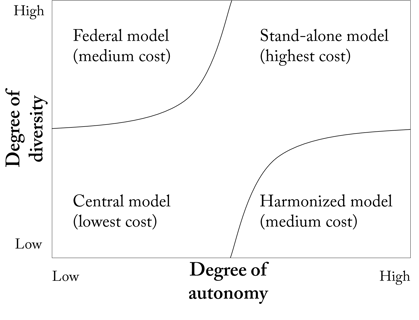Imagine the following scene: The CIO is summoned to the boardroom to explain herself. The smoke is still thick after yet another lost battle over IT synergies. The different parts of the business desperately try to clean up the debris and treat the wounded. All that remains is to execute the sentence… and to restore trust.
But let’s rewind for a while. Did the Board really think that IT could realize synergies without a thorough assessment of the Business Strategy and Business Governance? An organization’s direction and prioritization define the areas with realistically attainable IT synergies. Value maximization and synergies should be a joint top management question and can never be driven by IT in isolation.
The synergy trap often escalates to synergy war
We are not surprised to meet clients who expect to realize millions of Euros through IT synergies in the post-M&A phase. Given its often high cost and alluring economies of scale, IT is an obvious target. After all, how difficult can it be to move two companies operating in 11 countries to the same business applications? Very difficult, as it turns out. IT is probably still one of the least understood areas among top management, despite its growing importance in most businesses.
While the value proposition of harmonization and centralization can seem obvious, addressing sediments of legacy IT after years of growth often proves to be hard-won business cases. The desire to drive synergies through IT, head-to-head with the way the business is governed and without considering the diversity of business models in place, is sometimes referred to as the synergy trap.
IT can never win a synergy war in a decentralized organization with a high degree of autonomy, nor be the sole driver behind harmonization of business processes.
Setting the foundation allows you to navigate your IT synergy options
Our simple view on IT synergies is this: setting the foundation by laying out the desired outcome based on the corporate culture and business logic will help you to navigate your synergy options. Is the overall priority 1) to harmonize the business side, thus enabling centralization of core processes, or is it 2) to allow for a highly autonomous organization? Lacking agreement, the endeavor to synergize IT risks resulting in endless discussions, time wasted, and expectations not met.
Agreeing on commonalities and setting up necessary governing bodies will dramatically increase the chances of attaining sustainable synergies. The key is to identify where different organizational needs align and can give up “deciding on their own IT”.
Business Strategy and Business Governance define the critical capabilities with realistically attainable IT synergies. Hence, the key to understanding the options is a joint view and assessment of diversity and autonomy in your company; how diverse are we in terms of processes, requirements and priorities? Are these real or perceived differences? What mix of agile and traditional governance models do we want and how should that affect which synergies to chase?
From a diversity and autonomy standpoint, there are four broad synergy options (none of them represent the “right place” to be):

- The Central Model will work for an organization with low diversity and low autonomy: enabling all IT synergy levers, from harmonized and centralized infrastructure to shared applications.
- The Stand-alone model in contrast reflects high diversity and autonomy. In this case, not many IT synergy levers are available. The typical target would be common IT infrastructure, but even this can be difficult to address.
- The Federal model reflects high diversity and low autonomy. IT synergies would typically arise within core business and specific IT niches, such as integration and analytics. In this model IT could act as facilitator and help uncover business commonalities – over time reducing diversity.
- The Harmonized model will suit an organization characterized by low diversity and high autonomy. Although the synergy potential is clear, the limitation is similar to that of the stand-alone model if autonomy is sufficiently high.
Needless to say, a dual mode option is possible. For example, the benefits of creating a local edge might outweigh the gains from centralization depending on the market. This also allows an organization to operate according to agile and traditional governance models in parallel.
What would have happened if the Board had listened to the CIO?
Fast-forward to a parallel dimension: the CIO is celebrated in the boardroom for cannily guiding the business through different IT synergy options. The program was a success and well exceeded everyone’s expectations. These were the key insights:
- Business Strategy and Business Governance that define the areas with realistically attainable IT synergies. The focus should be on maximizing these areas’ values.
- The key to knowing the synergy options is an honest understanding of the organization’s diversity and autonomy. IT cannot single-handedly drive synergies that are not in line with business logic and corporate culture.
- There is no “right” place to be. Understand where the organization is and what can be done - realistically. If the organization still wants to move, make sure to understand what is required.
Business Strategy Alignment and Business Governance are critical capabilities to enable IT synergies. Centigo’s Assent framework gives our view of these individual capabilities, and others needed to design a future-proof IT operating model.
Are you interested in learning more about the Assent framework?


